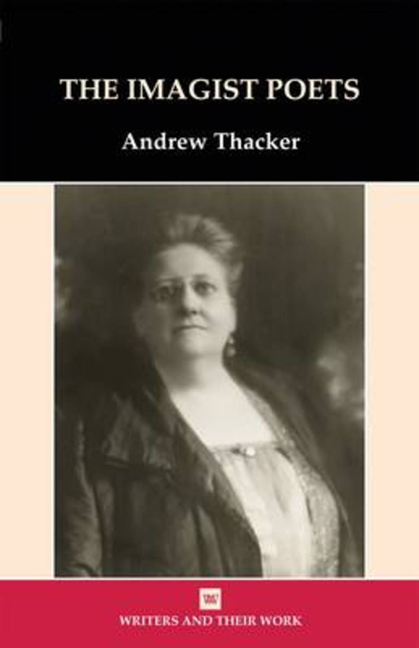Book contents
- Frontmatter
- Dedication
- Contents
- Acknowledgements
- Biographical Outlines
- Abbreviations
- Introduction: The Formation of Imagism
- 1 Movements and Modernism
- 2 Publishing, Publicity, and Magazines
- 3 Prefaces and Manifestos
- 4 Modern Themes
- 5 Urban Images
- 6 Gender and Sexuality: ‘Amygism’ and ‘H.D. Imagiste’
- Afterword
- Notes
- Select Bibliography
- Index
4 - Modern Themes
- Frontmatter
- Dedication
- Contents
- Acknowledgements
- Biographical Outlines
- Abbreviations
- Introduction: The Formation of Imagism
- 1 Movements and Modernism
- 2 Publishing, Publicity, and Magazines
- 3 Prefaces and Manifestos
- 4 Modern Themes
- 5 Urban Images
- 6 Gender and Sexuality: ‘Amygism’ and ‘H.D. Imagiste’
- Afterword
- Notes
- Select Bibliography
- Index
Summary
This chapter considers a number of Imagist poems in the light of some of the different theories discussed in the previous chapter. It looks, in particular, at two significant aspects that help delineate the modernism of Imagist verse: the use of a visual concrete language, as theorized by Hulme and Pound; and the employment of images of Orientalism in a variety of the poems. The preface to the 1915 anthology had boldly asserted that ‘We believe passionately in the artistic value of modern life’, but had qualified this with a dig at the technologically obsessed Futurists: ‘there is nothing so uninspiring nor so old-fashioned as an aeroplane of the year 1911’ (IP 135). The modern life that Imagism believed in could, to some eyes, look remarkably old- fashioned. However, a closer inspection shows how even poems based upon ancient Greek or early Chinese poetry demonstrate a keen engagement with the modernity of the early twentieth century. Pound, for one, believed that early Japanese and Chinese poetry exhibited precisely the technique of a ‘direct treatment of the thing’ that he felt was vital for the reform of modern verse in English.
Writing to Harriet Monroe, early in 1915, Pound bombarded the editor of Poetry with recommendations upon poetic style. Many of these are familiar from the other Imagist manifestos: poetry must be close to speech; it should eschew ‘book words’, periphrasis and inversions; the language must be ‘simple’ and ‘hard’ with ‘no words flying off to nothing’; abstractions are to be avoided, as must clichés and journalese, and the way to escape from these faults is by concentration and ‘precision’. One phrase, however, stands out in this letter, exhibiting a stark claim that reveals much about Imagist technique: ‘Language is made out of concrete things’, writes Pound, adding that it is lazy to use generalizations in ‘non-concrete terms’ for they are ‘the reaction of things on the writer, not a Creative act by the writer’. Imagist poems, therefore, would be those that exemplified this view of words as concrete things, where the writer acts upon their material, much in the way that a sculptor acts upon a block of stone (an analogy of which Pound was fond). It seems a development of the first principle of ‘Imagisme’, with the call for a ‘direct treatment of the thing’ being transferred onto the verbal material of poetry itself.
- Type
- Chapter
- Information
- The Imagist Poets , pp. 53 - 66Publisher: Liverpool University PressPrint publication year: 2011



